The Classic Old Fashioned Beef Stew Recipe: Cozy Comfort in a Bowl
Hearty beef stew has been a comforting classic in kitchens across America for generations.
Slow-cooked meals bring warmth to chilly evenings and connect us to cherished memories.
Tender chunks of meat mingle with robust vegetables, creating a symphony of flavors that dance on your palate.
Rich broth simmered with herbs and spices tells a story of traditional cooking techniques passed down through decades.
Rustic and soul-satisfying, this dish speaks to the heart of home-style cooking.
Each spoonful promises a delicious journey through culinary nostalgia.
You’ll want to savor every single bite of this timeless comfort food.
What Makes Old Fashioned Beef Stew So Classic
Ingredients for Old Fashioned Beef Stew
Main Protein:Aromatics:Flavor Enhancers:Liquid Base:Vegetables:Seasoning:Cooking Fat:How to Prepare Old Fashioned Beef Stew
Step 1: Sear the Meat
Heat olive oil in a large pot over medium-high heat. Add beef stew meat and brown on all sides, creating a rich golden crust that locks in flavor.
This process develops deep, caramelized notes that will enhance the overall taste of the stew.
Step 2: Develop Aromatic Base
Toss chopped onions and minced garlic into the pot.
Sauté until the onions become translucent and soft, releasing their sweet and savory fragrance throughout the kitchen.
Step 3: Create Flavor Foundation
Sprinkle flour over the meat and onions, then stir in tomato paste.
Cook this mixture for a couple of minutes to eliminate the raw flour taste and create a thick, rich base for the stew.
Step 4: Build the Liquid Layer
Pour in beef broth, bringing the mixture to a gentle boil.
Add these herbs and seasonings:Step 5: Slow Simmer
Reduce heat and let the stew simmer quietly for 1.5 hours. Stir occasionally to prevent sticking and ensure even cooking.
The meat will become incredibly tender during this time.
Step 6: Add Vegetables
Introduce these hearty vegetables to the pot:Cook for an additional 30 minutes until the vegetables are perfectly tender but not mushy.
Step 7: Final Touch and Serve
Remove the bay leaf. Taste and adjust seasonings as needed.
Ladle the steaming stew into deep bowls and serve immediately with crusty bread for a comforting meal.
Tips for a Hearty Old Fashioned Beef Stew
Variations for Old Fashioned Beef Stew
Serving Suggestions for Old Fashioned Beef Stew
How to Store Old Fashioned Beef Stew
FAQs
Browning the beef creates a rich, caramelized exterior that develops deep flavor and helps seal in the meat’s juices, giving the stew a more complex and delicious taste.
While beef chuck is traditional, you can substitute with other tough cuts like beef round or even lamb shoulder that become tender with slow cooking.
Cook the stew on low heat and simmer gently. The long, slow cooking process breaks down tough muscle fibers, making the meat tender and succulent.
Dried thyme works perfectly fine. Use about one-third of the amount of dried herbs compared to fresh herbs to maintain the right flavor intensity.
Print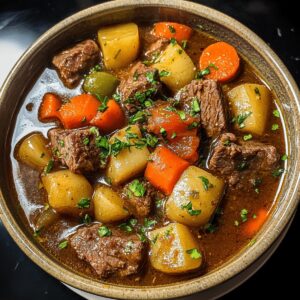
Hearty Old Fashioned Beef Stew Recipe
- Total Time: 2 hours 25 minutes
- Yield: 6 1x
Description
Hearty old fashioned beef stew blends tender meat with robust vegetables in a rich, savory broth. Slow-cooked comfort brings warmth to your table with classic midwestern flavors you’ll savor.
Ingredients
Meat:
- 2 pounds (907 grams) beef stew meat, cubed
Vegetables:
- 4 large potatoes, peeled and diced
- 4 carrots, sliced
- 1 large onion, chopped
- 3 garlic cloves, minced
Liquids and Seasonings:
- 4 cups (946 milliliters) beef broth
- 2 tablespoons tomato paste
- 2 tablespoons flour
- 2 tablespoons olive oil
- 1 teaspoon thyme
- 1 bay leaf
- Salt
- Pepper
Instructions
- Warm olive oil in a spacious pot over medium-high heat and thoroughly sear beef chunks until golden brown on all surfaces, creating a rich caramelized exterior.
- Incorporate diced onions and minced garlic into the pot, sautéing until vegetables become translucent and fragrant, approximately 3-4 minutes.
- Sprinkle flour and tomato paste into the mixture, stirring continuously to create a thick, smooth base and prevent scorching, cooking for 2 minutes to eliminate raw flour taste.
- Gradually pour beef broth into the pot, increasing heat to bring liquid to a rolling boil while introducing thyme, bay leaf, salt, and pepper for depth of flavor.
- Reduce heat to low, cover pot, and allow stew to simmer gently for 90 minutes, occasionally stirring to prevent sticking and ensure even cooking.
- Introduce cubed potatoes and sliced carrots into the stew, continuing to simmer uncovered for an additional 30-40 minutes until vegetables become tender and meat reaches ultimate tenderness.
- Discard bay leaf, taste and adjust seasonings as needed, then ladle the hearty stew into serving bowls, ensuring each portion contains a balanced mix of meat and vegetables.
Notes
- Enhance browning by patting beef dry before searing to develop deep, rich caramelized flavors.
- Customize stew thickness by adjusting flour quantity or using cornstarch for gluten-free alternative.
- Replace beef with mushrooms or plant-based protein for vegetarian version while maintaining hearty texture.
- combine all ingredients and cook on low for 8 hours for tender, melt-in-your-mouth meat.
- Prep Time: 15 minutes
- Cook Time: 2 hours 10 minutes
- Category: Lunch, Dinner
- Method: Simmering
- Cuisine: American
Nutrition
- Serving Size: 6
- Calories: 335 kcal
- Sugar: 3 g
- Sodium: 410 mg
- Fat: 14 g
- Saturated Fat: 5 g
- Unsaturated Fat: 8 g
- Trans Fat: 0.3 g
- Carbohydrates: 22 g
- Fiber: 3 g
- Protein: 29 g
- Cholesterol: 85 mg

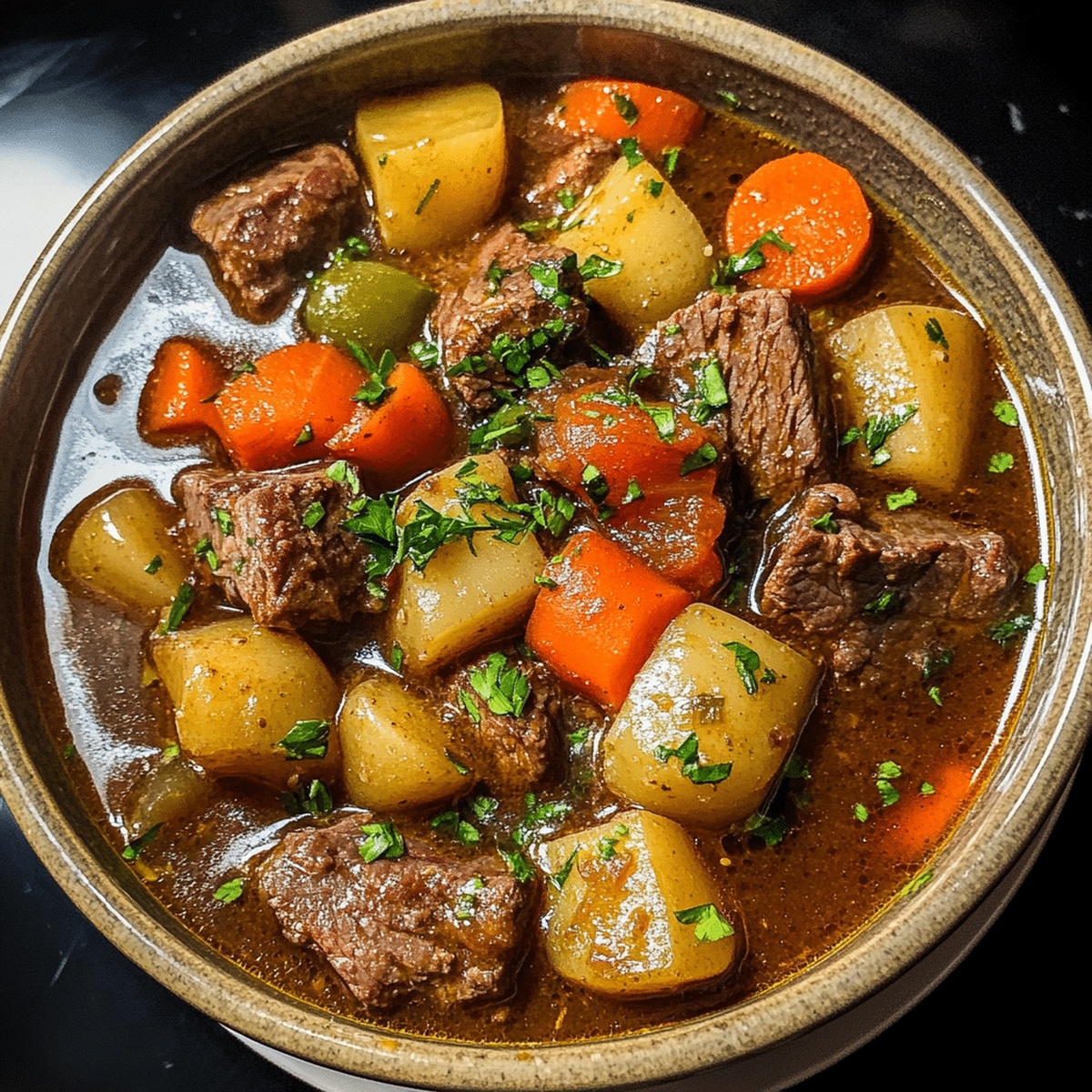
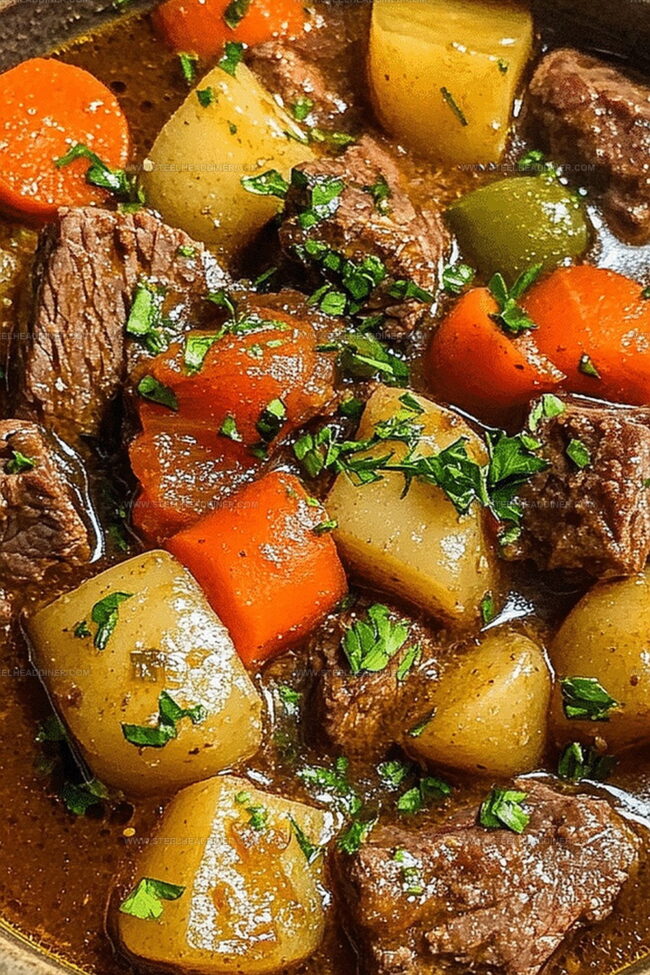
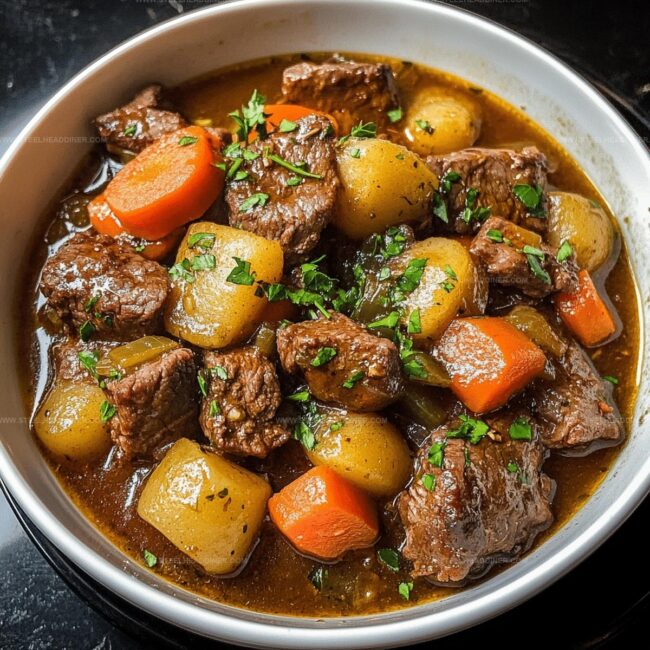
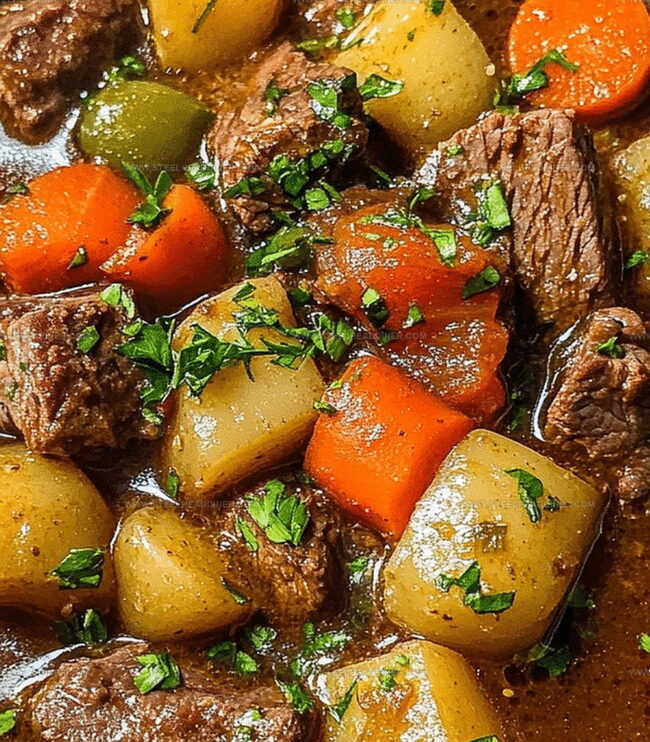
Jack Monroe
Founder & Recipe Innovator
Expertise
Pacific Northwest cuisine, Single-serving recipe development, Sustainable sourcing and cooking, Modern comfort food
Education
Brightwater
Associate of Applied Science in Culinary Arts
Focus: Sustainable cooking, seasonal ingredients, and food systems education
Jack grew up with a fishing rod in one hand and a cast-iron skillet in the other. After graduating from Brightwater: A Center for the Study of Food, he set out to prove that cooking for one could still taste like a feast.
Jack believes that food should feel real: fresh, fearless, and a little wild, just like the rivers he grew up around. For Jack, every single dish is a small adventure, and the best ones are the ones you can cook with heart, not hassle.